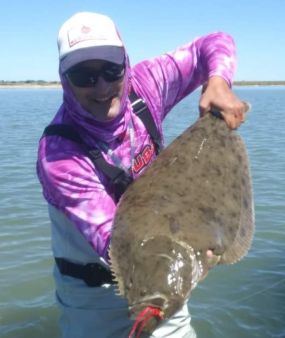Choosing the Right Fly Line Backing
BrodyMonday, February 16, 2015
Choosing the right fly line backing could make the difference when you hook that fish of a lifetime. Fly Line backing is something most freshwater fly fishermen don’t get to see very often but with saltwater anglers, when the fishing is good, fly line backing spends a lot of time outside of the fly reel. But even in freshwater fly fishing for trout, bass or any other popular species, backing is an important part of any fly fishing system that often gets overlooked. It is your last connection between you and Mr Big and needs to be maintained and changed periodically.
Many times in the fly shop while adding a new fly line to a reel, I notice that the backing is ancient, dirty, cracked and knotted and wrapped around itself. This is a recipe for disaster. Backing does break down and will break when you need it most if you neglect it. It’s a good idea to put new backing on with each fly line change or to at least examine it to make sure it is in good shape.
Fly Line Backing Details
1.Fly line backing performs a couple of duties. The first and most obvious is to “back-up” the length of your fly line with added distance while fighting fish that make long runs. This is rarely necessary while trout fishing but you will see your backing racing away when you hook a permit, roosterfish or any other popular saltwater species as well as with salmon or steelhead.
2. Backing also gives your fly line a platform to rest on while wrapped on the arbor or spool of your fly reel. This is important because the extra diameter provided by the backing keeps you fly line from being wrapped too tightly in small circles around the arbor. The bigger the diameter of these wraps of fly line, the better as this prevents your fly line from becoming kinked and developing memory coils that affect casting performance and create unwanted knots and tangles. Spool your backing methodically and cleanly to avoid overlapping wraps that can knot or tangle at the most inopportune times.
3. Backing generally comes in a couple of popular strengths and materials. The most typically used backing is braided nylon in either 20lb or 30lb test strength. For light duty saltwater and most freshwater fly fishing, 20 lb is fine. The heavier gauge 30 lb is generally reserved for tarpon and other larger saltwater fish. However, because I don’t need as much backing while fishing for trout, I use 30 lb because it fills up my reel faster with the larger diameter material.
4. Gel-spun backing is much more expensive than braided nylon backing but has a couple of advantages. It has a much smaller diameter and a higher breaking strength. This means you get much more backing on your fly reel’s spool which may be important for fish that make, long extended runs like billfish. Just be careful when that backing is screaming off the reel because the small diameter will cut your fingers quickly when moving at high speeds.
Hatch’s new Premium PE Braided Backing combines the best of both worlds. It is smaller in diameter than typical nylon braid, tests at 30 lbs and won’t slice you as quickly as gel spun.
5. How much backing do you need? It depends on the size of your reel and the fish you are targeting. For trout 50-100 yards is more than enough while bonefish or permit might require 200 yards. Tarpon, Marlin or sailfish even more-250-400 yards. Shallow large arbor reels may not hold as much backing as reel spools with a deeper arbor. The key is to match your fly reel’s spool with the fly line and make sure you leave adequate room after the backing has been spooled for your fly line to fit on the reel. Too much backing is usually a bigger problem than not enough. Also keep in mind that 200 yards is long ways and once a fish gets that far away from you (an 1/8 of a mile), luck as much backing will determine if you land that fish.
6. You are going to want a fly line backing that you can see easily. It makes tracking your fish much easier and lets you know if something like coral, branches, rocks or fast current is likely to have an impact on whether you land your fish or not. White is a popular color but it can be easily lost against a bright sky so I prefer fluorescent orange or chartreuse.
7. The best backing in the world won’t save you from bad knots so take your time when attaching backing to fly lines. A simple arbor knot is all that is necessary for anchoring your backing to the reel spool. For fly line attachments, nail knots or Albright knots work well. Back them up with a little super glue or UV Knot Sense from Loon.
For questions on rigging up or choosing fly line backing, ask the experts at the Vail Valley Anglers fly shop.
Brody Henderson, Guide and Content Writer





